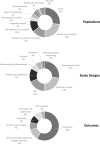Peer- and community-led responses to HIV: A scoping review
- PMID: 34852001
- PMCID: PMC8635382
- DOI: 10.1371/journal.pone.0260555
Peer- and community-led responses to HIV: A scoping review
Abstract
Introduction: In June 2021, United Nations (UN) Member States committed to ambitious targets for scaling up community-led responses by 2025 toward meeting the goals of ending the AIDS epidemic by 2030. These targets build on UN Member States 2016 commitments to ensure that 30% of HIV testing and treatment programmes are community-led by 2030. At its current pace, the world is not likely to meet these nor other global HIV targets, as evidenced by current epidemiologic trends. The COVID-19 pandemic threatens to further slow momentum made to date. The purpose of this paper is to review available evidence on the comparative advantages of community-led HIV responses that can better inform policy making towards getting the world back on track.
Methods: We conducted a scoping review to gather available evidence on peer- and community-led HIV responses. Using UNAIDS' definition of 'community-led' and following PRISMA guidelines, we searched peer-reviewed literature published from January 1982 through September 2020. We limited our search to articles reporting findings from randomized controlled trials as well as from quasi-experimental, prospective, pre/post-test evaluation, and cross-sectional study designs. The overall goals of this scoping review were to gather available evidence on community-led responses and their impact on HIV outcomes, and to identify key concepts that can be used to quickly inform policy, practice, and research.
Findings: Our initial search yielded 279 records. After screening for relevance and conducting cross-validation, 48 articles were selected. Most studies took place in the global south (n = 27) and a third (n = 17) involved youth. Sixty-five percent of articles (n = 31) described the comparative advantage of peer- and community-led direct services, e.g., prevention and education (n = 23) testing, care, and treatment programs (n = 8). We identified more than 40 beneficial outcomes linked to a range of peer- and community-led HIV activities. They include improved HIV-related knowledge, attitudes, intentions, self-efficacy, risk behaviours, risk appraisals, health literacy, adherence, and viral suppression. Ten studies reported improvements in HIV service access, quality, linkage, utilization, and retention resulting from peer- or community-led programs or initiatives. Three studies reported structural level changes, including positive influences on clinic wait times, treatment stockouts, service coverage, and exclusionary practices.
Conclusions and recommendations: Findings from our scoping review underscore the comparative advantage of peer- and community-led HIV responses. Specifically, the evidence from the published literature leads us to recommend, where possible, that prevention programs, especially those intended for people living with and disproportionately affected by HIV, be peer- and community-led. In addition, treatment services should strive to integrate specific peer- and community-led components informed by differentiated care models. Future research is needed and should focus on generating additional quantitative evidence on cost effectiveness and on the synergistic effects of bundling two or more peer- and community-led interventions.
Conflict of interest statement
The authors have declared that no competing interests exist.
Figures
References
-
- Declaration of Alma-Ata. International Conference on Primary Health Care; 1978; Geneva Switzerland: World Health Organization.
-
- Gillespie AM, Obregon R, El Asawi R, Richey C, Manoncourt E, Joshi K, et al.. Social Mobilization and Community Engagement Central to the Ebola Response in West Africa: Lessons for Future Public Health Emergencies. Glob Health Sci Pract. 2016;4(4):626–46. doi: 10.9745/GHSP-D-16-00226 - DOI - PMC - PubMed
-
- Towards a global action plan for healthy lives and well-being for all: uniting to accelerate progress towards the health-related SDGs. Geneva: World Health Organization; 2018. Contract No.: WHO/DCO/2018.3.
Publication types
MeSH terms
Grants and funding
LinkOut - more resources
Full Text Sources
Medical



